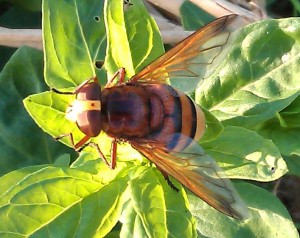A Gardener’s Friend – It’s Much Less Bother with a Hover
Guest blog by London Wetland Centre’s Chief Ecologist Richard Bullock

Many hoverflies mimic wasp colouration to avoid being attacked by predators such as birds. This is an example of Batesian mimicry - harmless species mimicking ‘dangerous’ species, and thereby gaining protection from visual targeting by natural enemies. Over 270 species have been recorded in the UK, and more than 85 species have been found in a single garden. Hoverfly adults are usually on the wing from March into early November. Adults mainly feed on nectar and pollen, whilst the larvae of most species are voracious predators of aphids and other garden pests. As a result, hoverflies should be viewed as a gardener’s best friend, acting both as a pollinator and pest controller. Female hoverflies require nectar and pollen to mature their eggs. They then use aphid honeydew as a cue to locate aphid colonies.
The Marmalade Hoverfly Episyrphus balteatus is the commonest and perhaps one of our most distinctive hoverflies, and is annually encountered at the London Wetland Centre as well as being a regular visitor to residential gardens across London. No more than about a centimetre in length, it is an abundant hoverfly whose numbers are often bolstered by migration from the continent in late summer. There is evidence to indicate that some adults succeed in hibernating through the winter. A single larva can devour 200 aphids during its development.

There is one hoverfly genus (Volucella sp.) in Britain comprising five species, of which all occur in the London area. They are amongst the most spectacular of our large hoverflies – mimicking bees, wasps and hornets. Four are scavengers associated with bumblebee and social wasp nests, whereas one is attracted to sap runs on trees. Two species (Voluncella inanis - pictured above -and Volucella zonaria - right) are nationally scarce and both these are regularly recorded in London and annually at London Wetland Centre. Volucella zonaria is the largest of our British hoverflies. It only became resident in the UK in the 1940s. London has been and still is a stronghold of this species, and is quite frequent in the outer London suburbs.
More than 30 species of hoverfly have been recorded at the London Wetland Centre. The best place to see hoverflies on site is on a wide variety of favoured nectar plants (e.g. to be found in the Butterfly Garden and the RBC Rain Garden). For example, plants such as Butterfly-bush, Bramble, Ivy, Hogweed, Wild Angelica, thistles, privets and Hebe sp. are all favoured by Volucella inanis and Volucella zonaria. Indeed, hoverflies are now viewed as being exceptionally important as pollinators of flowers. Where bees are scarce (particularly relevant today when the decline of the Honeybee is on people’s mind), they play an important role in the pollination of fruit trees and other commercial crops. However, their greatest contribution is probably in the pollination of garden flowers and wild plants, where the pollen loads collected on the hairs of visiting hoverflies can be as great as those carried by bees.
Therefore, next time we all go out to cut the grass in the garden with the hover mower, let us take a moment to reflect that a fly of the same name is very much lending a ‘helping hand’ with the gardening too.



